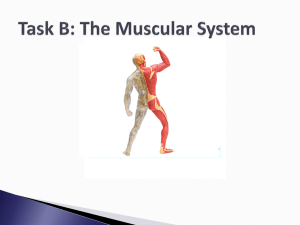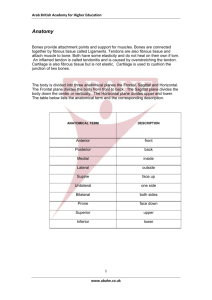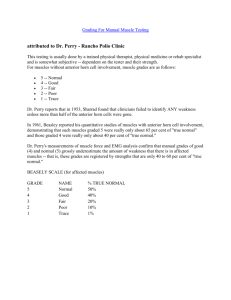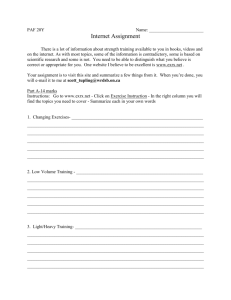Pre-course Study Materials - World Fitness Association
advertisement
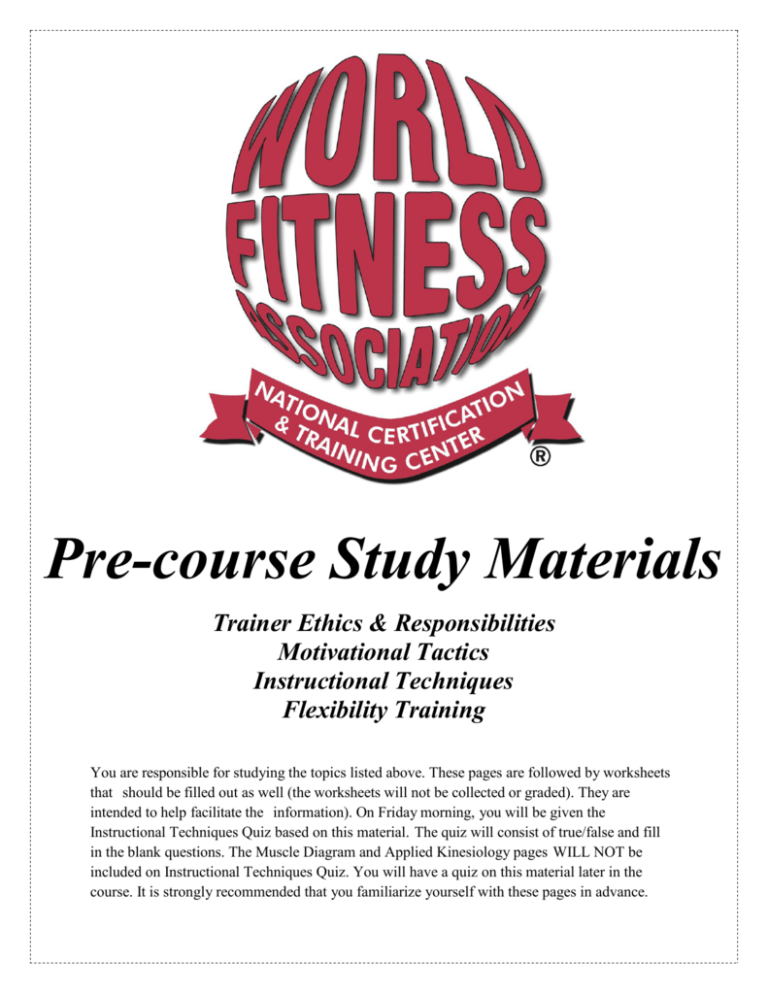
Pre-course Study Materials Trainer Ethics & Responsibilities Motivational Tactics Instructional Techniques Flexibility Training You are responsible for studying the topics listed above. These pages are followed by worksheets that should be filled out as well (the worksheets will not be collected or graded). They are intended to help facilitate the information). On Friday morning, you will be given the Instructional Techniques Quiz based on this material. The quiz will consist of true/false and fill in the blank questions. The Muscle Diagram and Applied Kinesiology pages WILL NOT be included on Instructional Techniques Quiz. You will have a quiz on this material later in the course. It is strongly recommended that you familiarize yourself with these pages in advance. TOP TEN Trainer Responsibilities 1. Providing professional guidance and expertise 2. Ensuring safe exercise participation 3. Emphasizing proper form and technique 4. Progressively increasing frequency, intensity and duration 5. Accountability 6. Efficient and effective workouts 7. Providing a wide variety of exercises 8. Regular progress evaluations 9. Dynamic, fun and exciting workouts 10. Exceeding client expectations Trainer Ethics Provide Safe and Effective Instruction Providing safe and effective instruction involves a variety of responsibilities for certified fitness professionals. Safe means that the instruction will not result in physical, mental or financial harm to the client. Great effort and care must be taken in carrying out the responsibilities that are essential in creating a positive exercise experience for all participants. Establish and Maintain Clear Professional Boundaries Working in the fitness industry requires personal trainers to come in contact with many different people. It is imperative that a professional distance be maintained in relationships between trainer and client. Trainers are responsible for setting and monitoring the boundaries between a working relationship and personal friendship with their clients. Certified personal trainers should: • • • • • Never initiate or encourage discussion of a sexual nature Avoid touching clients unless it is essential to instruction Inform clients about the purpose of touching and find an alternative if the client objects Discontinue all touching if it appears to make the client uncomfortable Take all reasonable steps to ensure that any personal and social contacts between trainer and client do not have an adverse impact on the trainerclient relationship If it is not possible to maintain appropriate professional boundaries with a client, the proper course of action would be to inform the fitness director so the situation can be formally documented. The next step would be to terminate the relationship and possibly refer the client to another trainer. Keep in mind that charges of sexual harassment or assault, even if groundless, can have disastrous effects on your personal training career. Motivational Tactics Motivating clients starts with maximizing the rate of improvement and minimizing the risk of injury. Be sure that every training session is a fun and exciting exercise experience. After every training session, be sure to build anticipation for the next scheduled personal training appointment. It is essential for personal trainers to carefully and consistently record each workout for their clients. Clients’ progress should be routinely reviewed with necessary exercise modifications implemented. By keeping detailed records of training sessions, clients will have an added incentive to keep purchasing training sessions once they begin to see personal improvements. Another excellent form of motivation is performance feedback (reinforcing comments and complimenting). Encouragement and positive reinforcement are highly motivational, particularly for beginner clients who may be lacking confidence in themselves. Performance feedback should always be shared in positive and encouraging manner. To be the most meaningful, performance feedback or reinforcing comments should contain specific information emphasizing those things that the client is doing well. A final factor for client motivation is YOU. Your physical appearance, training regularity, exercise technique, and personal attitude provide an example that can significantly increase your client’s enthusiasm for training. Different clients may need different verbal cues. The best cues will be the ones that work! Clear communication between the client and trainer is imperative to the success of the program and the client achieving his or her goals. The following are some verbal motivational cues to keep in mind to help the client get the most out of each training session: Verbal Motivational Cues: Opening: “That’s a cool looking t-shirt that you’re wearing today!” “You’re making this exercise look too easy!” “We‘re going to have to start adding more weight soon!” “Perfect posture and form!” “Keep up that intensity!” “Only 5 reps remaining! Finish strong!” Closing: “Awesome energy today! I wish all of my clients came in this motivated!” Instructional Techniques The role of a certified personal trainer is the active process of advising, correcting, and educating their clients. Instead of encouraging dependence, the personal trainer’s objective should be to enable the client to take more control and become self-sufficient. The specific role of a personal trainer can be very complex as they will act as a teacher, coach, supporter, counselor, as well as a financial negotiator. To be successful, trainers should be attentive to the following: 1. Posture: Specific postures will communicate your interest. To express your engagement, face the client at eye level and lean toward them in a relaxed manner. Research has shown that these postural behaviors demonstrate to the client the traits of empathy and genuineness. 2. Positioning: Position yourself at an appropriate distance from the client to demonstrate a respect for his or her personal space. Positioning yourself too far away could be interpreted as a lack of confidence. Be sensitive to the client and use your best judgment to decide the most professional distance. 3. Eye Contact: Good eye contact is a key sign for indicating interest in a person. Eye contact enables the client to feel comfortable and conveys your true interest at the same time. 4. Body Language: Nervous mannerisms such as playing with objects, pacing, and drumming fingers should be avoided. A person’s expressions, gestures, posture and other actions provide a constant source of information. 5. Voice Inflection: An effective communicator is aware of the quality of delivery of the message. Some personal trainers speak so softly that they cannot be heard, while others speak with such volume that they become overbearing. Your voice should be loud enough to be heard, while reserving a range to emphasize important points or for added motivation while training. “Tell – Show – Do” Instruction Method Tell: The explanation should be a detailed verbal description of the exercise that gives a clear understanding of what must be performed. Show: The demonstration is the visual presentation of the exercise or movement. You MUST be very aware of your exercise technique, body positioning, and safety tips. Do: The performance is the client’s opportunity to perform the exercise. Carefully monitor the client’s performance to correct errors and encourage proper exercise technique. Emphasize Proper Breathing Patterns Correct breathing ensures the body is receiving adequate amounts of oxygen for working muscles. Proper breathing includes exhaling during the most strenuous phase of the movement (exhale on the exertion). Proper breathing during strenuous activity cannot be over emphasized. Verbal Instructional Cues: Maintain a neutral head position Stand tall with the head up and shoulders back Maintain a flat back posture Engage the abdominals at all times Control the weight or resistance Breath in through the nose and out through the mouth Exhale on the exertion Create 90o angles Exercise Progressions and Modifications As a certified personal trainer, it is your responsibility to properly select safe, yet challenging exercises. In order to accomplish this, a basic understanding of exercise progressions (making an exercise more challenging) and modifications (making an exercise easier) is important. There are five kinetic chain checkpoints that are recommended to review for each exercise to ensure that proper technique is being demonstrated. By maintaining proper alignment in these five checkpoints, the effectiveness of the exercise will be enhanced and there will be a decreased risk of injury. Regardless of body position (standing, seated, prone, supine, multi-directional movement, or high intensity activities), proper alignment at each checkpoint needs to be maintained. Five Kinetic Chain Checkpoints: 1. 2. 3. 4. 5. Head neutral Shoulders slightly retracted Hips and low back demonstrate a neutral pelvis with core engaged Knees aligned with hips and feet Feet straight Exercise Progressions Exercise Modifications - Increase load (weight or resistance) - Decrease load (weight or resistance) - Increase intensity (decrease rest periods) - Decrease intensity (increase rest periods) - Increase frequency (sets, reps) - Decrease frequency (sets, reps) - Single-joint to multi-joint movements - Multi-joint to single-joint movements - Single plane to multiple plane motions - Multiple plane to single plane motions - Stable (bench) Unstable (stability ball) - Unstable (ball) Stable (bench) - Two legs One leg - One leg Two legs Flexibility Training Flexibility is an essential component of physical fitness and has been consistently shown to be highly specific to the individual, to the activity, and to each joint. Each client will have a different musculature, joint structure, and genetic composition. Personal trainers have the responsibility to create flexibility training programs that are specific to each one of their clients. Advantages of flexibility training: • • • • • • • • Relieves muscle tension Improves posture and balance Increases range of motion Prevents muscle and joint injuries by elongating and relaxing muscles Flushes out lactic acid Improves circulation and blood flow giving muscles added flexibility to move freely Improves coordination, balance, and accuracy Improves recovery time Muscles, tendons and ligaments are not immediately ready for the extreme range of motion required for most physical activity. Before starting any stretching routine, it’s more effective and efficient if the muscles are already warmed up. The warm-up increases circulation and blood flow to muscles and gets them ready to work. The warm-up also helps to reduce stiffness, making the muscles more flexible, so they stretch more easily. Perform a “dynamic” warm-up instead of jogging on a treadmill or exercise bike. Perform bodyweight lunges, throwing exercises, or squat jumps – any movement in which joints move through a full range of motion. This will increase circulation and blood flow to the muscles and joints while also prepping the central nervous system to work. Improper stretching can cause injury. Injury can occur when muscles are tight or cold and occasionally because the client is doing too much too fast. Instead, pay attention to the body’s signals and don’t push too far. Avoid ballistic stretching, which uses bouncing or jerking movements to gain momentum. Muscles should be slowly stretched to their endpoint of movement and held for about 25-30 seconds. The idea is to have the muscles recognize that they are being stretched. Two types of stretching that provide the best results are Static and Dynamic muscle stretching. Dynamic Muscle Stretching – stretching that is done by gradually increasing the stretch distance and speed of movement with each successive repetition in a particular direction. This should be a slow controlled movement where the limit of the muscle gradually increases (dynamic muscle stretching is the same as a dynamic warm-up). Static Muscle Stretching – holding a stretch with low force for about 25-30 seconds. This type of stretching is the way to increase flexibility. It’s important not to use too much pressure. Repeat the stretch in sets for the same length of time and force. It is important that flexibility training programs emphasize major muscle groups that are important in postural correction. If time is limited, the focus should be to target the client’s individual needs based on their flexibility assessment. Often the shoulders, chest, hamstrings, and hips are particularly tight. Flexibility training programs should be tailored to the clients’ strengths and weaknesses. Flexibility training can also help to improve muscle imbalance. A muscle imbalance is caused when some muscles are more warmed up and ready for exertion than others. If muscles are not stretched equally, they are said to be imbalanced. Muscle imbalances make you less coordinated and can contribute to injury such as pulled or strained muscles. Functional flexibility improves the stability and mobility of the whole person in their specific environment or lifestyle. For example: golfers, swimmers and tennis players. Individualized stretching programs improve both stability (the ability to maintain ideal body alignment during all activities) and mobility (the ability to use full, normal range of motion). Have clients dynamically warm-up/stretch before the training session and static stretch during and/or after the training session. The more time and attention spent on flexibility training, the more benefits the client will experience. Do not fall into the category of trainers who neglect to educate and incorporate flexibility training into their workouts. Verbal Stretching Cues: “Maintain control of your breathing at all times.” “Inhale when releasing a stretch and returning to the original position.” “Exhale during the exertion or reaching phase of the stretch.” “Breath into the stretch.” Trainer Ethics, Motivational Tactics, Instructional Techniques Worksheet 1. What does safe mean? 2. Why is clear communication so important? 3. are responsible for setting the boundaries between a working relationship and friendship with their clients. 4. If it is not possible to maintain appropriate professional boundaries with a client, what would be the next steps in the proper course of action? 5. Performance feedback should always be shared in manner. and 6. Explain the “Tell – Show – Do” Instruction Method 7. Before starting any stretching routine, it’s more effective and efficient if the muscles are . 8. Muscles should be slowly stretched to their endpoint of movement and held for about seconds. 9. List the 5 kinetic chain checkpoints. 10. Give 2 examples of exercise modifications. 11. Give 2 examples of exercise progressions. 12. Why is maintaining proper alignment so important? Flexibility Worksheet 1. is an essential component of physical fitness and has been consistently shown to be highly specific to the individual, to the activity, and to each joint. 2. are not immediately ready for the extreme range of motion required for most physical activity. 3. What does the warm-up increase? 5. List more effective warm-up options besides jogging on a treadmill or riding an exercise bike? 6. The 2 types of stretching are: 1. 2. 7. Provide 3 verbal stretching ques. 8. What is ballistic stretching? Why should it be avoided? 9. Explain the difference between dynamic stretching and static stretching. 10. What are advantages of flexibility training? 31 Posterior View Anterior View Muscle Diagram Answer Key 0 - Posterior Deltoid 16 - Anterior Deltoid 1 - Upper Trapezius 17 - Rotator Cuff 2 - Middle Trapezius 18 - Pectoralis Major 3 - Lower Trapezius 19 - Pectoralis Major 4 - Teres Major and Minor 20 - Pectoralis Minor 5 - Rhomboids 21 - Serratus Anterior 6 - Latissimus Dorsi 22 - Rectus Abdominis 7 - Erector Spinae 23 - Internal and External Obliques 8 - Medial Deltoid 24 - Gluteus Maximus 9 - Brachialis 25 - Gluteus Medius 10 - Biceps Brachii 26 - Hip Adductors 11 - Triceps Brachii 27 - Quadriceps 12 - Triceps Brachii 28 - Hamstrings 13 - Triceps Brachii 29 - Gastrocnemius 14 - Wrist Extensors 30 - Tibialis Anterior 15 - Wrist Flexors 31 - Soleus FRONT RAISE LATERAL RAISE OVERHEAD SHOULDER PRESS UPRIGHT ROW INTERNAL SHOULDER ROTATION EXTERNAL SHOULDER ROTATION BENT OVER LATERAL RAISE SHRUGS BACK EXTENSION SEATED ROW BENT OVER ROW PULL DOWN CHEST PRESS PULLOVER CHEST FLY PUSH UP TRICEPS PUSHDOWN TRICEPS OVERHEAD EXTENSION TRICEPS KICKBACK SKULL CRUSHER BARBELL CURL REVERSE CURL HAMMER CURL SQUAT SEATED LEG EXTENSION LUNGE LEG PRESS STANDING CALF RAISE LEG CURL DEADLIFT CRUNCH SIDE BEND LEG RAISE DIAGONAL CHOP SEATED “RUSSIAN” TWIST FRONT PLANK Applied Kinesiology Kinesiology is the study of human function and deals specifically with the mechanics of movement. The purpose of learning the locations and functions of skeletal muscles, as well as the mechanics of movement, is to enhance your ability to design effective and appropriate exercise programs. SHOULDERS Front Raise Agonist muscle(s) Anterior Deltoid Stabilizer and synergist muscles: Lateral Deltoid Pectoralis Major Biceps Brachii Upper Trapezius Serratus Anterior Overhead Shoulder Press Agonist muscle(s) Anterior Deltoid and Medial Deltoid Stabilizer and synergist muscles: Triceps Brachii Middle Trapezius Biceps Brachii Serratus Anterior Lateral Raise Upright Row Agonist muscle(s) Agonist muscle(s) Medial Deltoid Stabilizer and synergist muscles: Anterior Deltoid Middle Trapezius Lower Trapezius Serratus Anterior Posterior Deltoid Stabilizer and synergist muscles: Medial Deltoid Upper Trapezius Middle Trapezius Lower Trapezius Serratus Anterior Biceps Brachii Internal Shoulder Rotation External Shoulder Rotation Agonist muscle(s) Agonist muscle(s) Rotator Cuff Muscles Rotator Cuff Muscles Stabilizer and synergist muscles: Stabilizer and synergist muscles: Anterior Deltoid Latisimus Dorsi Anterior Deltoid Latisimus Dorsi Bent Over Lateral Raise Shrugs Agonist muscle(s) Agonist muscle(s) Posterior Deltoid Upper Trapezius Stabilizer and synergist muscles: Stabilizer and synergist muscles: Medial Deltoid Pectoralis Major Middle Trapezius Lower Trapezius Teres Minor Rhomboids Erector Spinae Middle Trapezius BACK Back Extension Agonist muscle(s) Erector Spinae Stabilizer and synergist muscles: Gluteus Maximus Hamstring Bent Over Row Agonist muscle(s) Latisimus Dorsi Rhomboids Middle Trapezius Lower Trapezius Teres Major Stabilizer and synergist muscles: Posterior Deltoid Biceps Brachii Seated Row Pull Down Agonist muscle(s) Agonist muscle(s) Latisimus Dorsi Rhomboids Middle Trapezius Lower Trapezius Teres Major Latisimus Dorsi Stabilizer and synergist muscles: Rhomboids Middle Trapezius Lower Trapezius Posterior Deltoid Biceps Brachii Teres Major Stabilizer and synergist muscles: Posterior Deltoid Biceps Brachii CHEST Chest Press Chest Fly Agonist muscle(s) Agonist muscle(s) Pectoralis Major Stabilizer and synergist muscles: Pectoralis Minor Triceps Brachii Anterior Deltoid Pectoralis Major Stabilizer and synergist muscles: Pectoralis Minor Biceps Brachii Anterior Deltoid Pullover Push Up Agonist muscle(s) Agonist muscle(s) Pectoralis Major Latissimus Dorsi Pectoralis Major Stabilizer and synergist muscles: Stabilizer and synergist muscles: Posterior Deltoid Triceps Brachii Pectoralis Minor Triceps Brachii Anterior Deltoid Erector Spinae Rectus Abdominis ARMS Triceps Pushdown Triceps Kickback Agonist muscle(s) Agonist muscle(s) Triceps Brachii Stabilizer and synergist muscles: Deltoids Triceps Brachii Stabilizer and synergist muscles: Deltoids Triceps Overhead Extension Skull Crusher Agonist muscle(s) Agonist muscle(s) Triceps Brachii Stabilizer and synergist muscles: Anterior Deltoid Triceps Brachii Stabilizer and synergist muscles: Anterior Deltoid Barbell Curl Reverse Curl Agonist muscle(s) Agonist muscle(s) Biceps Brachii Wrist Extensors Biceps Brachii Stabilizer and synergist muscles: Stabilizer and synergist muscles: Brachialis Wrist Flexors Brachialis Hammer Curl Agonist muscle(s) Brachialis Stabilizer and synergist muscles: Biceps Brachii LEGS Squat Lunge Agonist muscle(s) Agonist muscle(s) Quadriceps Stabilizer and synergist muscles: Hamstrings Gluteus Maximus Gastrocnemius Soleus Tibialis Anterior Quadriceps Hamstring Gluteus Maximus Stabilizer and synergist muscles: Gastrocnemius Soleus Tibialis Anterior Seated Leg Extension Leg Press Agonist muscle(s) Agonist muscle(s) Quadriceps Quadriceps Stabilizer and synergist muscles: Rectus Abdominis Tibialis Anterior Stabilizer and synergist muscles: Hamstrings Gluteus Maximus Gastrocnemius Soleus Standing Calf Raise Leg Curl Agonist muscle(s) Agonist muscle(s) Gastrocnemius Stabilizer and synergist muscles: Soleus Tibialis Anterior Deadlift Agonist muscle(s) Hamstrings Gluteus Maximus Erector Spinae Stabilizer and synergist muscles: Upper Trapezius Middle Trapezius Rhomboids Quadriceps Rectus Abdominis Hamstring Stabilizer and synergist muscles: Gastrocnemius Soleus Tibialis Anterior CORE Crunch Side Bend Agonist muscle(s) Agonist muscle(s) Rectus Abdominis Stabilizer and synergist muscles: Obliques Obliques Erector Spinae Stabilizer and synergist muscles: Rectus Abdominis Leg Raise Seated “Russian” Twists Agonist muscle(s) Agonist muscle(s) Rectus Abdominis Stabilizer and synergist muscles: Obliques Hip Flexors Obliques Stabilizer and synergist muscles: Rectus Abdominis Erector Spinae Diagonal Chop Front Plank Agonist muscle(s) Agonist muscle(s) Obliques Latissimus Dorsi Deltoids Stabilizer and synergist muscles: Rectus Abdominis Erector Spinae Biceps Brachii Triceps Brachii Rectus Abdominis Erector Spinae Stabilizer and synergist muscles: Trapezius Deltoids Rhomboids Serratus Anterior Gluteus Maximus Quadriceps Gastrocnemius Kinesiology Worksheet Provide the appropriate Agonist muscle(s) for each movement. Overhead Shoulder Press Lateral Raise Agonist muscle(s) Agonist muscle(s) Deltoid Deltoid Deltoid Upright Row Overhead Pull Down Agonist muscle(s) Agonist muscle(s) Deltoid Front Raise Bent Over Lateral Raise Agonist muscle(s) Agonist muscle(s) Deltoid Deltoid Seated Row External Shoulder Rotation Agonist muscle(s) Agonist muscle(s) Dorsi Trapezius Trapezius Teres Cuff Back Extension Shrugs Agonist muscle(s) Agonist muscle(s) _ Trapezius Chest Press Overhead Extension Agonist muscle(s) Agonist muscle(s) Brachii Barbell Curl Reverse Curl Agonist muscle(s) Agonist muscle(s) Wrist Brachii Hammer Curl Squat Agonist muscle(s) Agonist muscle(s) Lunge Seated Leg Extension Agonist muscle(s) Agonist muscle(s) Maximus Standing Calf Raise Leg Curl Agonist muscle(s) Agonist muscle(s) Deadlift Side Bend Agonist muscle(s) Agonist muscle(s) Erector Gluteus Seated “Russian Twists Front Plank Agonist muscle(s) Agonist muscle(s) Rectus Spinae Crunch Agonist muscle(s)


